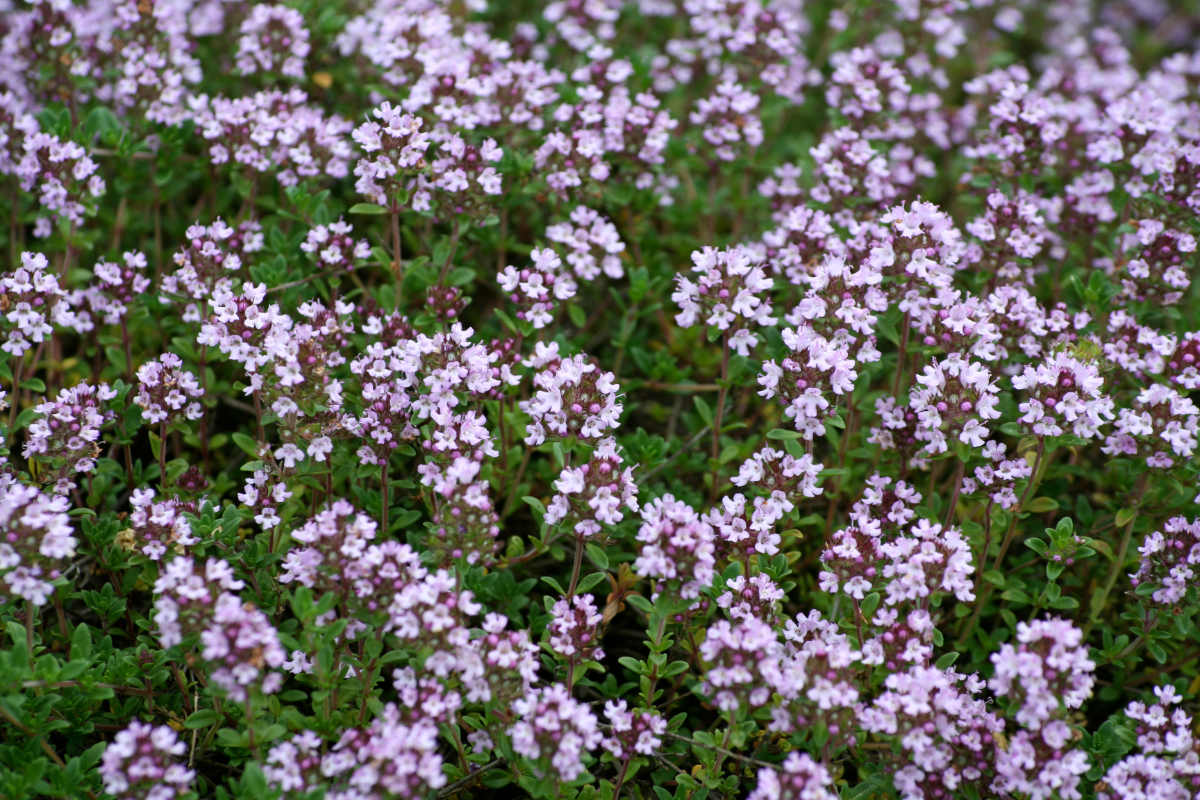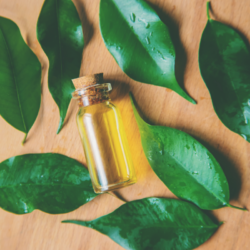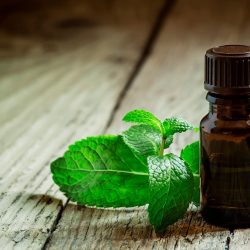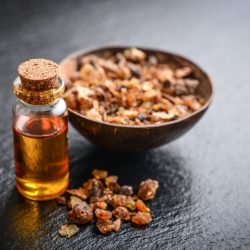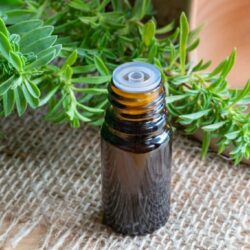Thyme Linalol essential oil, derived from Thymus vulgaris ct linalol, is a multi-purpose elixir in the arsenal of modern phytotherapy. Known for its unique composition and diverse therapeutic properties, this essential oil stands out for its mildness and effectiveness. This article aims to explore in detail the botanical characteristics, health benefits and varied applications of Linalol Thyme essential oil, based on current scientific data.
We will look at its origins, its specific chemical composition and its role in various therapeutic contexts. From its antimicrobial impact to its neurotonic effects, every aspect will be examined to understand why Linalool Thyme oil is becoming increasingly popular in the world of natural health and well-being. In addition, we will highlight the methods of use, recommended dosages and precautions to be taken for optimal and safe use.
This comprehensive guide will not only provide invaluable information for aromatherapy enthusiasts and health professionals, but also for anyone wishing to enrich their natural care kit with a versatile and effective essential oil.
What are the characteristics of Thyme ct Linalol?
Thyme ct linalol, from its botanical name Thymus vulgaris ct linalol, belongs to the Lamiaceae family.
What are its botanical attributes?
Thymus vulgaris L., also known as Thyme or Farigoule, is a sub-shrub measuring between 10 and 30 cm. It is distinguished by its green pigmentation, which varies between whitish and greyish shades, and emits a highly aromatic fragrance. The woody stems of the plant are either erect or ascending, do not root and are twisted, forming a compact, densely clumped bush.
The branches are tomentose-whitish on all sides. In contrast, the relatively small leaves are lanceolate-rhomboid or linear, with obtuse tips and rolled edges. They are not ciliated at the base and have a short, dense tomentum on the underside. The species flowers between April and July. Thyme’s flowers are pink or white, arranged in globular heads or spikes with separate lower whorls. The hairy calyx has a tube that is slightly humped at the base.
What is its habitat and distribution?
In terms of its ecology, Thymus vulgaris is commonly found in dry, arid environments in the south of France. It extends its range to areas such as the Hautes-Alpes, Drôme, Lozère and Aveyron. It is also found in Spain, the Balearic Islands and Italy.
Thymus vulgaris is used extensively in the cultivated sector, where it sometimes appears as a subspontaneous plant.
As far as its environmental preferences are concerned, common thyme prefers slightly acidic, well-drained, rocky soil, exposed to plenty of direct sunlight. It does, however, adapt well to alkaline, filtering, light or compact soil that is slightly damp and cool.
Phytosociologically, Thymus vulgaris originates from arid, calcareous environments in the Mediterranean basin. Following Neolithic forest clearance, it found itself in a position of conquest. Slash-and-burn pastoralism and coppice treatment have perpetuated this situation. Its predominance and expansion are evident in areas that have been anthropised. Examples include grazed wasteland, abandoned fields and fire protection zones. It also thrives on road and rail embankments, thanks to its notable allelopathic properties.
How is the chemotype induced?
It’s also worth mentioning that thyme is subdivided into different chemotypes. Variability is influenced by environmental and climatic factors. These include altitude, soil and photoperiod. For example, the thymol chemotype, which is the most abundant, is distinguished by its low-altitude habitat. The linalool chemotype, on the other hand, grows in medium-altitude habitats, with a predominant presence in the Alps and the Midi. Phytochemical studies have revealed a diversity of compounds in the essential oils of different populations of Thymus vulgaris, confirming significant intraspecific variability.
The chemotype of Thymus vulgaris known as “linalol” is distinguished from other chemotypes by its more branched and bushy morphology. Its stature is smaller and more compact. Although thyme is indigenous to the countries of the Mediterranean basin and neighbouring territories under Mediterranean climatic influence, it has nevertheless demonstrated an ability to adapt and thrive in subtropical, warm or temperate regions, specifically in Europe and North America.
What are the uses of Thyme CT linalol essential oil?
Thyme linalool essential oil is remarkable for its rich diversity of active molecules such as linalool, terpinen-4-ol and linalyl acetate, giving it a substantial range of therapeutic properties.
How does it work?
Thyme CT linalol essential oil has several biochemical constituents:
- Monoterpenols (~70%): linalool, geraniol, terpineol-4-ol
- Terpene esters (~16%): linalyl acetate
- Monoterpenes (~6%)
- Sesquierpenes (~4%)
- Terpene oxides (~2%)
The oil’s antimicrobial properties can be largely attributed to linalool and monoterpene alcohols. They show significant inhibition against various bacterial strains, including Campylobacter jejuni and Escherichia coli. The same molecular composition also promotes pronounced antiviral activity. This reinforces the oil’s potential for neutralising viral threats.
At the same time, the antifungal efficacy of the essential oil is specifically expressive against Candida albicans. This essential oil therefore has the potential to treat fungal infections. The oil’s anti-parasitic profile, highlighting its parasiticidal and vermifugal properties, proves effective against a range of parasites, such as tapeworms and pinworms. Neurologically, the oil’s neurotonic properties suggest beneficial stimulation of the central nervous system and other neuronal components, promoting its status as a psychic tonic.
In addition to these primary attributes, the oil also encompasses a number of secondary properties. These include antispasmodic and uterotonic effects, as well as aphrodisiac and positive properties.
Although supported by studies, the application and use of this essential oil must be scrupulously supervised by a health professional. This is to ensure a safe and relevant approach to individual and contextual specificities. The wide range of properties of Linalol Thyme essential oil makes it a potential candidate in a variety of therapeutic and pharmacological scenarios.
What are its indications?
The essential oil of Thyme with linalool chemotype is recognised in both scientific and traditional circles for a range of distinct properties and applications attributed to it, particularly in the therapeutic, cosmetic and energetic fields.
What are its scientifically-proven properties?
- It is appreciated for its gentle anti-infectious action, making it a relevant initial choice for chronic pathologies.
- It acts as an antibacterial and antiviral agent.
- Its properties also include antifungal, antiparasitic and deworming action.
- It acts as a parasiticide, targeting roundworms, pinworms and taenia in particular.
- It is a physical and, to a lesser extent, sexual tonic.
- It has a uterotonic action.
- It can act as a mild antispasmodic.
- This essential oil is suitable for paediatric use.
What are its traditional indications?
- It is used to treat intestinal infections such as gastritis, bacterial enterocolitis, candidiasis and parasitic colitis.
- It is involved in pulmonary infections such as bronchitis, pharyngitis, coughs, tuberculosis, pneumonia and pleurisy.
- It is used to alleviate dermatological disorders, including psoriasis, warts, mycosis and infectious dermatoses.
- It can be an asset in the treatment of gynaecological and urinary tract infections: cystitis, genital candidiasis, pyelonephritis, prostatitis, vaginitis and salpingitis.
- It helps during phases of physical and nervous fatigue, as well as during periods of convalescence
- It is used as an adjuvant in cases of diabetes.
What is thyme used for in cosmetics and energy?
Thyme essential oil is sometimes used in cosmetics:
- It is used to treat various skin conditions.
- It is a good choice for treating acne-prone skin and combination to oily skin.
- It is also used to treat oily hair.
Thyme also has energetic powers:
- It is known for its ability to positivise the emotional environment.
- It is neurotonic and stimulating.
- It has anti-depressant properties.
- It provides support in the event of communication difficulties.
- It encourages extroversion.
Thyme ct linalol essential oil thus combines a variety of properties that make it relevant in a range of applications, while reminding us of the need for informed use and, if possible, supervision by a health professional.
How should this chemotyped essential oil be used?
It is essential to determine the correct dosage and to understand the precautions to be taken when using Thyme ct linalol essential oil, particularly because of its high content of specific bioactive compounds.
What dosage should I choose?
Thyme linalool essential oil is an option in a variety of therapeutic contexts, thanks to its many properties.
- For a variety of infections,oral administration is common in adults and children over the age of six. Practitioners often combine this oil with other essential oils to optimise the effectiveness of the treatment.
- Dermatoses, mycoses and other skin afflictions are best treated by applying the oil to the skin. The oil, often combined with other essential oils and diluted in a vegetable oil, alleviates the symptoms. Specialists particularly recommend this approach for sensitive skin and paediatric treatment.
- In the case of pulmonary problems, unctions prepared by diluting the essential oil in a vegetable oil are applied to the chest and upper back to ease breathing and improve lung health. Finally, for complications linked to the ENT tract, the essential oil can be inhaled or diffused.
It is essential to stress the importance of adapting this advice to the specific situation and individual, while scrupulously respecting the precautions for using essential oils.
What are the precautions for use?
Thyme Linalol essential oil, also known as Red Thyme, is characterised by its mildness, making it particularly suitable for use by both children and the elderly, due to its pronounced tonic and antiseptic properties. However, despite its mildness, it must be diluted when applied to the skin or diffused.
- When applied to the skin, especially over a large area, it should be diluted 20% in a vegetable oil (i.e. a ratio of 20% essential oil and 80% vegetable oil).
- Oral use is strictly forbidden for children under 6 years of age and for pregnant or breast-feeding women.
- For atmospheric diffusion, Linalol Thyme essential oil should not be diffused pure, but rather diluted between 5 and 10% with other essential oils. Although Linalool Thyme essential oil is generally gentle to use and suitable for pregnant women (over 3 months of pregnancy) and children over 6 months of age, rigorous caution is essential.
It should be stressed emphatically that there are various varieties of thyme, some of which can be dangerous if used incorrectly. For example, specialists formally advise against the use of carvacrol common thyme (Thymus vulgaris sb Carvacrol) and thymol common thyme (Thymus vulgaris sb Thymol) for pregnant and breast-feeding women and children. For other populations, use must be carefully supervised and follow the instructions of an experienced professional.
What do the health authorities think of Thyme?
To look at the health authorities’ perspective on Thyme Linalool essential oil, we need to examine the official positions and recommendations issued by bodies such as the European Medicines Agency (EMA), the World Health Organisation (WHO) and other leading institutions in the health field. These opinions reflect the current state of scientific research and the approved applications of this product in the medical field.
What does the EMA say?
- The European Medicines Agency considers thyme to be ” traditionally used as an expectorant, to treat coughs and colds”. It recommends reserving its use for adults and children over the age of twelve.
- The scientific community recognises mixtures of thyme leaves and primrose root(Primula veris or P. elatior) for their medicinal use against coughs, either with a Marketing Authorisation (MA) indicating expectorant properties, or as a traditional remedy against coughs associated with colds for products without a MA. Products with marketing authorisation, combining thyme and primrose, are reserved for adults.
What is the WHO’s position on the use of thyme?
The World Health Organisation recognises the use of thyme “against dyspepsia (difficult digestion) and other gastrointestinal disorders, against coughs during colds or bronchitis, and as a gargle against laryngitis and inflammation of the tonsils”. Thyme’s antiseptic and healing properties are particularly useful when applied locally. For example, it can be used on superficial skin wounds and to treat mouth irritations.
How do Commission E and ESCOP view thyme?
- Commission E of the German Ministry of Health recognises the use of thyme in “bronchitis and productive coughs (which produce mucus), as well as colds”.
- The European Scientific Co-operation on Phytotherapy recognises the use of thyme “in catarrh of the upper airways, as a complementary treatment in the treatment of whooping cough, and to relieve mouth irritations and bad breath”.
What is the history and development of the use of Thyme through the ages?
Much more often found in the kitchen than in the medicine cabinet, thyme is one of those plants with a distant past, like so many around the Mediterranean. Even if its sacred nature is not immediately obvious, the fact remains that illustrious ancients had dealings with it.
What is the etymology of the word “thyme”?
First of all, etymology offers us some interesting clues to which thyme can be linked:
- Thymus – its current Latin name – comes from the Greek thymos. In ancient times, this was the name given to various small, fragrant plants in the Lamiaceae family.
- Thymos was thought to have something to do with perfume, as people used to burn thyme in order to smoke it.
- Secondly, the Greek word thuô refers to sacrifices offered to the gods (perhaps in connection with the previous point).
- Finally, the Greek word thumus evokes courage
Today, the word thyme, stabilised in this form since the 13th century, seems to have a connection with the gland known as thymus. We know that the ancient Greeks located the soul in this organ.
What role did thyme play in ancient times?
To explore the role of thyme in ancient times, it is essential to immerse ourselves in the historical and cultural context of that era. By referring to ancient writings and archaeological discoveries, we can trace the use and significance of thyme in ancient civilisations, where it played a crucial role in medicinal practices, rituals and daily life.
How did the Egyptians use it?
Practitioners used this plant, along with others such as savory, frankincense, myrrh, etc., to carry out the mummification ritual. And it cannot be said that they chose plants indiscriminately, simply because they knew the properties of these different plants on a corpse. To draw a parallel, today, thyme and savory are used to cure pheasant game.
Antiseptic and antibacterial, thyme stops the proliferation of bacteria and improves the preservation of mummies, some of which have survived to this day. This is proof of the Egyptians’ knowledge in this area.
In addition to the fragrance of the plants used for embalming, the embalmers had an in-depth knowledge of their medical properties. An essential oil does not camouflage a bad smell with its fragrance, it destroys it. We now know that many unpleasant odours are caused by the degradation of organic matter.
How was it used by the Greeks and Romans?
For almost a thousand years, this plant was frequently used both in cooking and in pharmacy by the ancients, and was mentioned in various writings. Hippocrates, the father of modern medicine, and Theophrastus, a philosopher, recognised its usefulness in cooking. They also highlighted its medicinal benefits. They distinguished between white thyme, praised for its medicinal properties, and black thyme, suspected of causing melancholy and biliary disorders.
These ancient classifications, based on the doctrine of signatures, prevailed at the time. The writings of Dioscorides and Pliny take a similar approach to the classification of thyme. However, they also include relevant notes on its many virtues: expectorant, cough suppressant, blood thinner and gastrointestinal tonic. Pliny may well be the first to mention thyme’s warming effect.
Thyme has gradually been incorporated into various medical practices and rituals over time. Galen, an ancient physician, recommended thyme to facilitate childbirth. In the fifth century, the Greek physician Aetius noted its soothing effect on the psyche. He prescribed it for people suffering from mental disorders, anger or melancholy. Moreover, its use was not limited to consumption or application. It also extended to invigorating baths, dry fumigations to purify the air, and various other forms of topical application such as poultices and massages.
Ancient civilisations have fashioned a variety of uses for thyme. The Greeks, for example, used it as incense in their temples and made potions that were supposed to infuse courage and bravery into combatants on the battlefield. The Greek word “Thumos”, meaning courage, bears witness to this association. Pliny praised its anti-infectious properties. Since ancient times, thyme has also been appreciated as a flavouring, in addition to its medicinal properties. This testifies to its versatility and its enduring presence across the ages and cultures.
How was thyme used in the Middle Ages?
The use of thyme during the Middle Ages oscillated between medical applications, religious and magical rituals, and culinary use. It was used in a variety of concoctions, from potions that would enable people to see fairies, to remedies to cure various physical ailments such as stiff neck.
Arab medicine in the 13th century, as illustrated by Ibn al-Baytar, valued thyme for its purifying and stimulating properties. It was used to cleanse the stomach and liver, relieve colic, treat mouth and throat diseases and strengthen the kidneys. The plant also enjoyed a reputation for its ability to stimulate copulation.
In the twelfth century, St Hildegard also advocated thyme as a remedy for conditions as varied as leprosy, paralysis and lice infestations. Widening the spectrum of its applications, she recognised and promulgated its anti-putrid properties. Indeed, she used the plant in medicinal baths. She also used it to make plasters and decoctions. These methods were designed to treat ulcers, “bad humours”, musculo-articular pain and other ailments.
In addition to these medical and ritual uses, thyme has also been incorporated into a variety of culinary preparations. It is particularly popular in Provençal cuisine, where it is a key ingredient. It plays an important role in Provençal herbs, bouquets garnis, dishes in sauce, and even in the production of liqueurs.
Throughout this period, thyme has travelled, establishing itself outside its native region thanks to the efforts of monks in the 11th century. Despite its relatively late introduction to certain regions, the plant became an established part of the medicinal and dietary practices of the time. It offers a tangible example of the blending of medical, religious and culinary knowledge in the Middle Ages.
How was it used during the Renaissance?
Although Matthiole makes almost no mention of thyme, it is found in Paracelsus’ Opodeldoch balm (1541). Later, it was used in the composition of what was known as ” tranquil ” balm (around the end of the 17th century). Around the same time, Louis XIV used thyme to treat toothache. Later, Nicolas Lémery described thyme as a cerebral tonic, digestive and antitoxic. Like Galen, he also described its ability to promote childbirth.
Known since at least the 16th century, thyme essential oil is gradually revealing its secrets. One of its active ingredients, thymol, was discovered as early as 1719.
What role has it played in modern times?
Developments in the understanding and use of thyme, and in particular its essential oil, intensified remarkably at the dawn of the 20th century. In 1887, Chamberland demonstrated the bactericidal efficacy of the oil against anthrax. Two years later, in 1889, Cadéac and Meunier studied its action against typhoid bacillus. In 1894, Mequel highlighted the bactericidal properties of thyme vapours, followed by Morel and Rochaix in 1921-1922. They highlighted other antibacterial actions against several pathogens. These included meningococcus and Eberth’s bacillus.
In the 1930s, Dr Henri Leclerc, in his “Précis de phytothérapie”, praised thyme not only for its physical properties, but also for its ability to boost moral strength. He relied on ancestral prescriptions. Other twentieth-century authors, such as Fournier and Valnet, highlighted the various properties of this aromatic plant. It is described as a tonic, stomachic, pectoral, antispasmodic and emmenagogue. Fournier recommended its infusion in cases of whooping cough and chronic bronchitis, and as a compress for rheumatic pains.
In traditional aromatherapy, thyme essential oil has been used to treat a variety of ailments. These range from intestinal and urinary disorders to various parasites. It is also recognised as an effective stimulant. In the 20th century, Valnet recommended its use for pulmonary and intestinal ailments. He also found it useful for specific pathologies such as whooping cough and various intestinal parasites.
Today, the scientific community recognises the virtues of thymol, the predominant molecule in thyme. It is widely used in the manufacture of a variety of products, including soaps and cosmetics. It is one of the natural remedies recommended for respiratory pathologies, particularly coughs and various infections.
References
- “Petit Larousse des Huiles Essentielles”, Thierry Folliard, éditions Larousse, Paris 2014.
- “Bible Larousse des Huiles Essentielles”, Thierry Folliard, éditions Larousse, Paris 2016.
- “ABC de l’herboristerie familiale”, Thierry Folliard, éditions Grancher, Paris 2009.
- “Traité approfondi de Phyto-Aromathérapie”, Dr Hervé Staub & Lily Bayer, Grancher 2013.
- “L’aromathérapie exactement”, Pierre Franchomme & Daniel Pénoël, Jollois 1990.
- “Guide pratique des huiles essentielles et hydrolats corses”, Christian Escriva, Editions Amyris, Brussels 2016.
- Astani A. et al, 2010. Phytotherapy Research. 24, 673-679.
- Brand C. et al., 2001. Inflammation Research. 50, 213-219.
- Budhiraja S.S. et al., 1999. Journal of Manipulative Physiological Therapeutics. 22, 447-453.
- Ghahremani-Chabok A. et al., 2021. Advances in Integrative Medicine. 8, 92-100.
- Guimarães A.G. et al., 2013. Phytotherapy Research. 27, 1-15.
- Horváth G. et al., 2021. BMC Complementary Medicine and Therapies. 21, 148.
- Kotan R. et al., 2007. Zeitschrift für Naturforschung C. 62, 507-513.
- Linck V.M. et al., 2009. Phytomedicine: International Journal of Phytotherapy and Phytopharmacology. 16, 303-307.
- Pattnaik S. et al., 1995. Microbios. 84, 195-199.
- Peana A.T. et al., 2003. European Journal of Pharmacology. 460, 37-41.
- Peana A.T. et al., 2002. Phytomedicine. 9, 721-726.
- Peana A.T. et al., 2004. European Journal of Pharmacology. 497, 279-284.
- Ramage G. et al., 2012. Frontiers in Microbiology. 3.
- Sardari S., 2021. Journal of Advanced Medical and Biomedical Research. 29, 83-91.
- Schmidt E. et al., 2012. Natural Product Communications. 7, 1095-1098.
- Yoshida K. et al., 2017. Neuroscience Letters. 653, 314-319.

